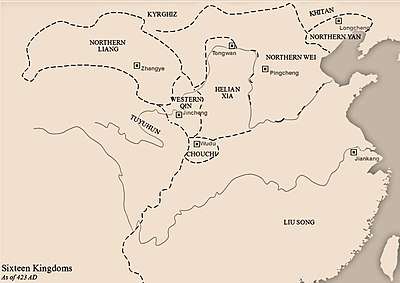Xia (Sixteen Kingdoms)
| Xia 夏 | |||||||||||
|---|---|---|---|---|---|---|---|---|---|---|---|
| 407–431 | |||||||||||
 Helian Xia in 423 | |||||||||||
| Capital |
Tongwan (418-427) Shanggui (427-428) Pingliang (428-430) | ||||||||||
| Government | Monarchy | ||||||||||
| Emperor | |||||||||||
• 407-425 | Helian Bobo | ||||||||||
• 425-428 | Helian Chang | ||||||||||
• 428-431 | Helian Ding | ||||||||||
| History | |||||||||||
• Established | 407 | ||||||||||
• Helian Bobo's claim of imperial title | 418 | ||||||||||
• Fall of Tongwan | 11 July 427[1][2] | ||||||||||
• Disestablished | 431 | ||||||||||
• Helian Ding's death | 13 May 432[3][4] | ||||||||||
| |||||||||||
Tiefu (simplified Chinese: 铁弗; traditional Chinese: 鐵弗; pinyin: Tiěfú) was a pre-state Xiongnu tribe during the era of Sixteen Kingdoms in China.[5] Its chieftain Liu Bobo established the state of Xia in 407 and changed his family name into Helian.
Although the Xia only lasted up to 431, its capital Tongwan (in Ordos) was certainly a heavily fortified and state-of-the-art city that would serve as a frontier garrison until the Song Dynasty. Its ruins were discovered during the Qing Dynasty and can still be seen in present-day Inner Mongolia.
The Wei Shu also records that Liu Kuren's tribe, the Dugu, were descended from the Xiongnu. Yao Weiyuan 姚薇元 suggested in the past that 'Dugu' was an alternate form of 'Tuge' 屠各, the Xiongnu aristocratic clan that had adopted the surname of Liu 刘, members of which also ruled the Former Zhao state. This writer further suggests that 'Tuge' is an alternate form of 'Tuhe' 徒河, which is the branch of the Xianbei from which the Murong 慕容 were descended. The Liu (Dugu) were also known as Tiefu 铁弗, a term which meant that they had Xiongnu fathers and Xianbei mothers. Thus it is reasonable to say that the Dugu were at least half Xianbei.
All rulers of the Xia declared themselves "emperors".
Chieftains of the Tiefu and rulers of the Xia
| Temple names | Posthumous names | Family names and given name | Durations of reigns | Era names and their according durations |
|---|---|---|---|---|
| Chinese convention: use family name and given name | ||||
| Chieftains of the Tiefu | ||||
| Did not exist | Did not exist | 劉去卑 Liú Qùbēi | 260-272 | Did not exist |
| Did not exist | Did not exist | 劉誥升爰 Liú Gàoshēngyuán | 272-309 | Did not exist |
| Did not exist | Did not exist | 劉虎 Liú Hǔ | 309-341 | Did not exist |
| Did not exist | Did not exist | 劉務恒 Liú Wùhéng | 341-356 | Did not exist |
| Did not exist | Did not exist | 劉閼陋頭 Liú èlòutóu | 356-358 | Did not exist |
| Did not exist | Did not exist | 劉悉勿祈 Liú Xīwùqí | 358-359 | Did not exist |
| Did not exist | Did not exist | 劉衛辰 Liú Wèichén | 359-391 | Did not exist |
| Did not exist | Did not exist | 劉勃勃 Liú Bóbó | 391-407 | Did not exist |
| Rulers of the Xia | ||||
| Shizu (世祖 Shìzǔ) | Wulie (武烈 Wǔliè) | 赫連勃勃 Hèlián Bóbó | 407-425 | Longsheng (龍升 Lóngshēng) 407-413 Fengxiang (鳳翔 Fèngxiáng) 413-418 Changwu (昌武 Chāngwǔ) 418-419 Zhenxing (真興 Zhēnxīng) 419-425 |
| Did not exist | Did not exist | 赫連昌 Hèlián Chāng | 425-428 | Chengguang (承光 Chéngguāng) 425-428 |
| Did not exist | Did not exist | 赫連定 Hèlián Dìng | 428-431 | Shengguang (勝光 Shèngguāng) 428-431 |
Rulers family tree
| Xia | |||||||||||||||||||||||||||||||||||||||||||||||||||||||||||||||||||||||||||||||||||||||||||||||||||||||||||||||||||||||||||||||||||||||||||||||||||||||||||||||||||||||||||||||||||||||||||||||||||||||||||||||||||||||||||||||||||||||||||||||||||||||||||||||||||||||||||||||||||||||||||||||||||||||||||||||||||||||||||||||||||||||||||||||||||||||||||||||||||||||||||||||||||||||||||||||||||||||||||||||||||||||||||||||||||||||||||||||||||||||||||||||||||||||||||||||||||||||||||||||||||||||||||||||||||||||||||||||||||||||||||||||||||||||||||||||||||||||||||||||||||||||||||||||||||||||||||||||||||||||||||||||||||||||||||||||||||||||||||||||||||||||||||||||||||||||||||||||||||||||||||||||||||||||||||||||||||||||||||||||||||||||||||||||||||||||||||||||||||||||||||||||||||||||||||||||||||||||||||||||||||||||||||||||||||||||||||||||||||||||||||||||||||||||||||||||||||||||||||||||||||||||||||||||||||||||||||||||||||||||||||||||||||||||||||||||||||||||||||||||||||||||||||||||||||||||||||||||||||||||
|---|---|---|---|---|---|---|---|---|---|---|---|---|---|---|---|---|---|---|---|---|---|---|---|---|---|---|---|---|---|---|---|---|---|---|---|---|---|---|---|---|---|---|---|---|---|---|---|---|---|---|---|---|---|---|---|---|---|---|---|---|---|---|---|---|---|---|---|---|---|---|---|---|---|---|---|---|---|---|---|---|---|---|---|---|---|---|---|---|---|---|---|---|---|---|---|---|---|---|---|---|---|---|---|---|---|---|---|---|---|---|---|---|---|---|---|---|---|---|---|---|---|---|---|---|---|---|---|---|---|---|---|---|---|---|---|---|---|---|---|---|---|---|---|---|---|---|---|---|---|---|---|---|---|---|---|---|---|---|---|---|---|---|---|---|---|---|---|---|---|---|---|---|---|---|---|---|---|---|---|---|---|---|---|---|---|---|---|---|---|---|---|---|---|---|---|---|---|---|---|---|---|---|---|---|---|---|---|---|---|---|---|---|---|---|---|---|---|---|---|---|---|---|---|---|---|---|---|---|---|---|---|---|---|---|---|---|---|---|---|---|---|---|---|---|---|---|---|---|---|---|---|---|---|---|---|---|---|---|---|---|---|---|---|---|---|---|---|---|---|---|---|---|---|---|---|---|---|---|---|---|---|---|---|---|---|---|---|---|---|---|---|---|---|---|---|---|---|---|---|---|---|---|---|---|---|---|---|---|---|---|---|---|---|---|---|---|---|---|---|---|---|---|---|---|---|---|---|---|---|---|---|---|---|---|---|---|---|---|---|---|---|---|---|---|---|---|---|---|---|---|---|---|---|---|---|---|---|---|---|---|---|---|---|---|---|---|---|---|---|---|---|---|---|---|---|---|---|---|---|---|---|---|---|---|---|---|---|---|---|---|---|---|---|---|---|---|---|---|---|---|---|---|---|---|---|---|---|---|---|---|---|---|---|---|---|---|---|---|---|---|---|---|---|---|---|---|---|---|---|---|---|---|---|---|---|---|---|---|---|---|---|---|---|---|---|---|---|---|---|---|---|---|---|---|---|---|---|---|---|---|---|---|---|---|---|---|---|---|---|---|---|---|---|---|---|---|---|---|---|---|---|---|---|---|---|---|---|---|---|---|---|---|---|---|---|---|---|---|---|---|---|---|---|---|---|---|---|---|---|---|---|---|---|---|---|---|---|---|---|---|---|---|---|---|---|---|---|---|---|---|---|---|---|---|---|---|---|---|---|---|---|---|---|---|---|---|---|---|---|---|---|---|---|---|---|---|---|---|---|---|---|---|---|---|---|---|---|---|---|---|---|---|---|---|---|---|---|---|---|---|---|---|---|---|---|---|---|---|---|---|---|---|---|---|---|---|---|---|---|---|---|---|---|---|---|---|---|---|---|---|---|---|---|---|---|---|---|---|---|---|---|---|---|---|---|---|---|---|---|---|---|---|---|---|---|---|---|---|---|---|---|---|---|---|---|---|---|---|---|---|---|---|---|---|---|---|---|---|---|---|---|---|---|---|---|---|---|---|---|---|---|---|---|---|---|---|---|---|---|---|---|---|---|---|---|---|---|---|---|---|---|---|---|---|---|---|---|---|---|---|---|---|---|---|---|---|---|---|---|---|---|---|---|---|---|---|---|---|---|---|---|---|---|---|---|---|---|---|---|---|---|---|---|---|---|---|---|---|---|---|---|---|---|---|---|---|---|---|---|---|---|---|---|---|---|---|---|---|---|---|---|---|---|---|---|---|---|---|---|---|---|---|---|---|---|---|---|---|---|---|---|---|---|---|---|---|---|---|---|---|---|---|---|---|---|---|---|---|---|---|---|---|---|---|---|---|---|---|---|---|---|---|---|---|---|---|---|---|---|---|---|---|---|---|---|---|---|---|---|---|---|---|---|---|---|---|---|---|---|---|---|---|---|---|---|---|---|---|---|---|---|---|---|---|---|---|---|---|---|---|---|---|---|---|---|---|---|---|---|---|---|---|---|---|---|---|---|---|---|---|---|---|---|---|---|---|---|---|---|---|---|---|---|---|---|---|---|---|---|---|---|---|---|---|---|---|---|---|---|---|---|---|---|---|---|---|---|---|---|---|---|---|---|---|---|---|---|---|---|---|---|---|---|---|---|---|---|---|---|---|---|---|---|---|---|---|---|---|---|---|---|---|---|---|---|---|---|---|---|---|---|---|---|---|---|---|---|---|---|---|---|---|---|---|---|---|---|---|---|---|---|---|---|---|---|---|---|---|---|---|---|---|---|---|---|---|---|---|---|
| |||||||||||||||||||||||||||||||||||||||||||||||||||||||||||||||||||||||||||||||||||||||||||||||||||||||||||||||||||||||||||||||||||||||||||||||||||||||||||||||||||||||||||||||||||||||||||||||||||||||||||||||||||||||||||||||||||||||||||||||||||||||||||||||||||||||||||||||||||||||||||||||||||||||||||||||||||||||||||||||||||||||||||||||||||||||||||||||||||||||||||||||||||||||||||||||||||||||||||||||||||||||||||||||||||||||||||||||||||||||||||||||||||||||||||||||||||||||||||||||||||||||||||||||||||||||||||||||||||||||||||||||||||||||||||||||||||||||||||||||||||||||||||||||||||||||||||||||||||||||||||||||||||||||||||||||||||||||||||||||||||||||||||||||||||||||||||||||||||||||||||||||||||||||||||||||||||||||||||||||||||||||||||||||||||||||||||||||||||||||||||||||||||||||||||||||||||||||||||||||||||||||||||||||||||||||||||||||||||||||||||||||||||||||||||||||||||||||||||||||||||||||||||||||||||||||||||||||||||||||||||||||||||||||||||||||||||||||||||||||||||||||||||||||||||||||||||||||||||||||
See also
Notes and references
- ↑ http://www.sinica.edu.tw/ftms-bin/kiwi1/luso.sh?lstype=2&dyna=%ABe%A7%BA&king=%A4%E5%AB%D2&reign=%A4%B8%B9%C5&yy=4&ycanzi=&mm=6&dd=&dcanzi=%A5%D2%A8%B0
- ↑ Zizhi Tongjian, vol. 120.
- ↑ http://www.sinica.edu.tw/ftms-bin/kiwi1/luso.sh?lstype=2&dyna=%ABe%A7%BA&king=%A4%E5%AB%D2&reign=%A4%B8%B9%C5&yy=9&ycanzi=&mm=3&dd=&dcanzi=%A4%D0%A5%D3
- ↑ Zizhi Tongjian, vol. 122.
- ↑ Grousset, Rene (1970). The Empire of the Steppes. Rutgers University Press. p. 61. ISBN 0-8135-1304-9.